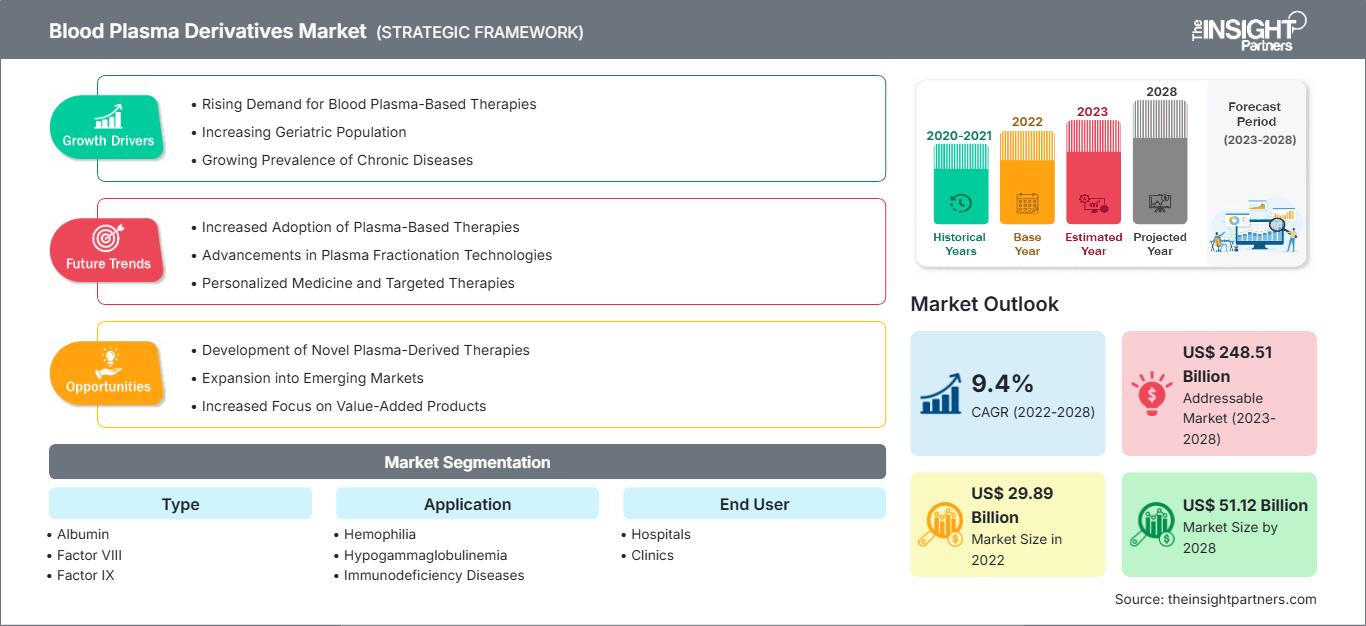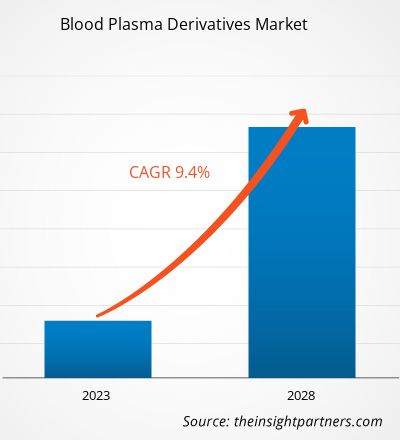[Forschungsbericht]Der Markt für Blutplasmaderivate wird voraussichtlich von 29.886,12 Millionen US-Dollar im Jahr 2022 auf 51.119,24 Millionen US-Dollar im Jahr 2028 anwachsen; von 2022 bis 2028 wird eine durchschnittliche jährliche Wachstumsrate (CAGR) von 9,4 % erwartet.
Plasmaderivate werden durch Fraktionierung aus bestimmten Plasmaproteinen gewonnen. Blutplasmaderivate enthalten hohe Mengen an Proteinen, Salzen, Mineralien, Hormonen, Vitaminen und Proteaseinhibitoren. Daher werden sie häufig zur Zerstörung von Viren eingesetzt, die Blutungsstörungen, Hepatitis B, Hepatitis C, Hämophilie A, Immunschwäche, Hypogammaglobulinämie, Hämophilie B und das humane Immundefizienzvirus auslösen.
Der Markt für Blutplasmaderivate ist nach Typ, Anwendung, Endverbraucher und Geografie segmentiert. Geografisch ist der Markt grob in Nordamerika, Europa, den asiatisch-pazifischen Raum, den Nahen Osten und Afrika sowie Süd- und Mittelamerika unterteilt. Der Bericht bietet Einblicke und eine detaillierte Marktanalyse mit Schwerpunkt auf Parametern wie Markttrends, technologischem Fortschritt und Marktdynamik sowie einer Analyse der Wettbewerbslandschaft der weltweit führenden Marktteilnehmer.
Passen Sie diesen Bericht Ihren Anforderungen an
Sie erhalten kostenlos Anpassungen an jedem Bericht, einschließlich Teilen dieses Berichts oder einer Analyse auf Länderebene, eines Excel-Datenpakets sowie tolle Angebote und Rabatte für Start-ups und Universitäten.
Markt für Blutplasmaderivate: Strategische Einblicke

-
Holen Sie sich die wichtigsten Markttrends aus diesem Bericht.Dieses KOSTENLOSE Beispiel umfasst Datenanalysen, die von Markttrends bis hin zu Schätzungen und Prognosen reichen.
Markteinblicke – Markt für Blutplasmaderivate
Zunehmender Einsatz von Immunglobulin G in verschiedenen Behandlungen bietet Chancen für den Markt für Blutplasmaderivate in den kommenden Jahren
Immunglobulin-G-Therapien (IgG) werden häufig zur Behandlung von primären Immundefekten aufgrund genetischer Defekte eingesetzt. Die Nachfrage nach IgG ist in den letzten Jahren aufgrund der zunehmenden Bekanntheit der IgG-Therapie stetig gestiegen. Basierend auf kontrollierten Studien, die mittels Netzwerk-Metaanalyse (NMA) durchgeführt wurden, wurde die IgG-Therapie zur Behandlung des Guillain-Barré-Syndroms (GBS), der chronisch inflammatorischen demyelinisierenden Polyneuropathie (CIDP), der multifokalen motorischen Neuropathie (MMN) und der Dermatomyositis zugelassen. IgG-Therapien sind auch zur Behandlung von Exazerbationen der Myasthenia gravis und des Stiff-Person-Syndroms wirksam. Darüber hinaus bietet es eine überzeugende Wirksamkeit bei Autoimmunerkrankungen wie Epilepsie, Neuromyelitis und Autoimmunenzephalitis.
- Im Jahr 2022 schloss Grifols eine Vereinbarung mit Canadian Blood Services. Diese Vereinbarung beschleunigt die Selbstversorgung Kanadas mit Immunglobulinen. Im Rahmen der Vereinbarung wird Grifols mit Canadian Blood Services zusammenarbeiten, um die Plasmabeschaffung in Kanada schrittweise zu erhöhen und bis 2026 ein Volumen von 2,4 Millionen Gramm Ig-Medikamenten pro Jahr zu erreichen.
- Im Jahr 2021 genehmigte die Food and Drug Administration (FDA) Cutaquig für den medizinischen Gebrauch. Es wird als Ersatztherapie bei primärer humoraler Immundefizienz (PI) bei Erwachsenen und pädiatrischen Patienten ab 2 Jahren verwendet. Cutaquig ist eine gebrauchsfertige Immunglobulinlösung zur subkutanen Infusion. Das Produkt ist in Einwegfläschchen zu 1 g, 1,65 g, 2 g, 3,3 g, 4 g oder 8 g erhältlich.
- Im August 2020 begann Kedrion Biopharma (Italien) mit der Verbesserung einer aus Plasma gewonnenen Behandlung zur Behandlung von COVID-19-Patienten. Die Behandlung könnte in drei bis einem halben Jahr für Patienten zugänglich sein.
Ein großer Teil von IgG wird in Fachgebieten außerhalb der Immunologie verwendet, beispielsweise in der Onkologie, Neurologie, Hämatologie und Rheumatologie. Im Vergleich zu allen anderen ist die Neurologie das am schnellsten wachsende Fachgebiet auf dem Weltmarkt. Das Wachstum des Immunglobulin-G-Marktes ist auf die Zulassung zur On-Label-Anwendung bei chronisch inflammatorischer demyelinisierender Polyneuropathie (CIDP) zurückzuführen, gefolgt von der Off-Label-Anwendung bei sekundären Immundefekten durch Lymphom, Myelom und Leukämie sowie bestimmten immunsuppressiven Therapien, insbesondere B-Zell-gerichteten Therapien. Somit wird die breite Anwendung von IgG in zahlreichen Behandlungen für bestimmungsgemäße und nicht bestimmungsgemäße Verwendung die weltweite Nachfrage nach IgG in den kommenden Jahren ankurbeln.
Einblicke für Endnutzer
Basierend auf dem Endnutzer ist der globale Markt für Blutplasmaderivate in Krankenhäuser, Kliniken und andere segmentiert. Das Segment Krankenhäuser hatte 2022 den größten Marktanteil und wird im Prognosezeitraum voraussichtlich die höchste durchschnittliche jährliche Wachstumsrate (CAGR) verzeichnen. Die steigende Zahl von Krankenhauseinweisungen und die zunehmende Prävalenz der Von-Willebrand-Krankheit, Immunschwächekrankheiten und Hämophilie werden das Marktwachstum des Krankenhaussegments im Prognosezeitraum voraussichtlich ankurbeln. Zudem erleben Schwellenländer eine enorme Nachfrage nach modernen Krankenhauseinrichtungen, um der wachsenden Patientenzahl und den zunehmenden Bedenken hinsichtlich der öffentlichen Gesundheit gerecht zu werden. Darüber hinaus werden in Krankenhäusern verschiedene Immunglobulinersatztherapien durchgeführt, um die Dosierungen und Nebenwirkungen der Therapie zu beobachten und die klinischen Ergebnisse des Produkts zu überwachen. Krankenhäuser sind die wichtigsten Zentren für die Bereitstellung von Immunglobulin-Ersatztherapien, die mithilfe neuer Technologien entwickelt werden. Patienten, die in Krankenhäusern Immunglobulin-Therapien erhalten, profitieren von der größeren Sicherheit, der engmaschigeren Überwachung und der Unterstützung durch medizinisches Fachpersonal und Experten. Daher wird erwartet, dass die von Krankenhäusern gebotenen Vorteile wie eine angemessene patientenorientierte Versorgung und die Verfügbarkeit von Erstattungsmöglichkeiten das Marktwachstum dieses Segments im Prognosezeitraum ankurbeln werden.
Produkteinführungen sowie Fusionen und Übernahmen gehören zu den häufig verfolgten Strategien der globalen Akteure auf dem Markt für Blutplasmaderivate. Einige der jüngsten wichtigen Produktentwicklungen sind nachstehend aufgeführt:
- Im April 2022 gab Grifols den Abschluss der Übernahme von 100 % des Aktienkapitals der Tiancheng (Germany) Pharmaceutical Holdings AG bekannt. Die Tiancheng (Germany) Pharmaceutical Holdings AG ist ein deutsches Unternehmen, das 89,88 % der Stammaktien und 1,08 % der Vorzugsaktien der Biotest AG hält. Nach Abschluss des öffentlichen Übernahmeangebots (PTO) und Abschluss der Übernahme kontrolliert Grifols 96,20 % der Stimmrechte und hält 69,72 % des Aktienkapitals der Biotest AG.
Markt für Blutplasmaderivate
Die Analysten von The Insight Partners haben die regionalen Trends und Faktoren, die den Markt für Blutplasmaderivate im Prognosezeitraum beeinflussen, ausführlich erläutert. In diesem Abschnitt werden auch die Marktsegmente und die geografische Lage in Nordamerika, Europa, dem asiatisch-pazifischen Raum, dem Nahen Osten und Afrika sowie Süd- und Mittelamerika erörtert.Umfang des Marktberichts zu Blutplasmaderivaten
| Berichtsattribut | Einzelheiten |
|---|---|
| Marktgröße in 2022 | US$ 29.89 Billion |
| Marktgröße nach 2028 | US$ 51.12 Billion |
| Globale CAGR (2022 - 2028) | 9.4% |
| Historische Daten | 2020-2021 |
| Prognosezeitraum | 2023-2028 |
| Abgedeckte Segmente |
By Typ
|
| Abgedeckte Regionen und Länder |
Nordamerika
|
| Marktführer und wichtige Unternehmensprofile |
|
Marktdichte von Blutplasmaderivaten: Auswirkungen auf die Geschäftsdynamik verstehen
Der Markt für Blutplasmaderivate wächst rasant. Die steigende Nachfrage der Endverbraucher ist auf Faktoren wie veränderte Verbraucherpräferenzen, technologische Fortschritte und ein stärkeres Bewusstsein für die Produktvorteile zurückzuführen. Mit der steigenden Nachfrage erweitern Unternehmen ihr Angebot, entwickeln Innovationen, um den Bedürfnissen der Verbraucher gerecht zu werden, und nutzen neue Trends, was das Marktwachstum weiter ankurbelt.
- Holen Sie sich die Markt für Blutplasmaderivate Übersicht der wichtigsten Akteure
Blutplasmaderivate – Marktsegmentierung
Der Markt für Blutplasmaderivate ist nach Typ in Albumin, Faktor VIII, Faktor IX, Immunglobulin, Hyperimmunglobulin und andere unterteilt. Der Markt für Immunglobulin ist weiter in IgG, IgM, IgA, IgD und IgE unterteilt. Nach Anwendung ist der Markt für Blutplasmaderivate in Hämophilie, Hypogammaglobulinämie, Immunschwächekrankheiten, Von-Willebrand-Syndrom und andere Anwendungen unterteilt. Nach Endverbraucher ist der Markt in Krankenhäuser, Kliniken und andere unterteilt. Geografisch ist der Markt für Blutplasmaderivate in Nordamerika (USA, Kanada und Mexiko), Europa (Frankreich, Deutschland, Großbritannien, Italien, Spanien und das übrige Europa), den asiatisch-pazifischen Raum (China, Japan, Indien, Australien, Südkorea und der übrige asiatisch-pazifische Raum), den Nahen Osten und Afrika (Saudi-Arabien, Südafrika, die Vereinigten Arabischen Emirate und der übrige Nahe Osten und Afrika) sowie Süd- und Mittelamerika (Brasilien, Argentinien und der übrige Süd- und Mittelamerika) unterteilt.
Unternehmensprofile – Markt für Blutplasma-Derivate
- Grifols, SA
- SK Plasma Co., Ltd.
- Fusion Healthcare
- Biotest AG
- Green Cross Corp
- Kedrion
- LFB SA
- Octapharma AG
- CSL Limited
- Takeda Pharmaceutical Company Begrenzt
- Historische Analyse (2 Jahre), Basisjahr, Prognose (7 Jahre) mit CAGR
- PEST- und SWOT-Analyse
- Marktgröße Wert/Volumen – Global, Regional, Land
- Branchen- und Wettbewerbslandschaft
- Excel-Datensatz
Aktuelle Berichte
Verwandte Berichte
Erfahrungsberichte
Grund zum Kauf
- Fundierte Entscheidungsfindung
- Marktdynamik verstehen
- Wettbewerbsanalyse
- Kundeneinblicke
- Marktprognosen
- Risikominimierung
- Strategische Planung
- Investitionsbegründung
- Identifizierung neuer Märkte
- Verbesserung von Marketingstrategien
- Steigerung der Betriebseffizienz
- Anpassung an regulatorische Trends






















 Kostenlose Probe anfordern für - Markt für Blutplasmaderivate
Kostenlose Probe anfordern für - Markt für Blutplasmaderivate